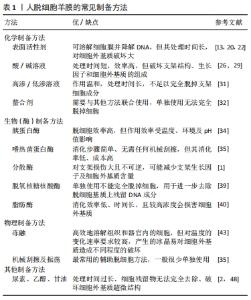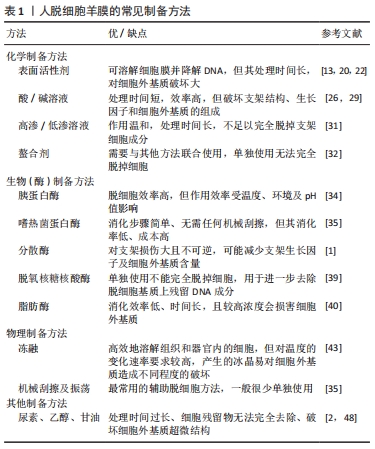Chinese Journal of Tissue Engineering Research ›› 2022, Vol. 26 ›› Issue (25): 4028-4033.doi: 10.12307/2022.410
Previous Articles Next Articles
Preparation and sterilization method of human acellular amniotic membrane scaffold
He Qi, Xu Faya, Li Xiyan, Han Lei, Xiao Yanbing, Tu Jiao
- Maternity & Child Healthcare Hospital Affiliated of Zunyi Medical University, Zunyi 563000, Guizhou Province, China
-
Received:2021-01-28Accepted:2021-03-06Online:2022-09-08Published:2022-01-26 -
Contact:Tu Jiao, Chief physician, Master’s supervisor, Maternity & Child Healthcare Hospital Affiliated of Zunyi Medical University, Zunyi 563000, Guizhou Province, China -
About author:He Qi, Master candidate, Maternity & Child Healthcare Hospital Affiliated of Zunyi Medical University, Zunyi 563000, Guizhou Province, China -
Supported by:the National Natural Science Foundation of China, No. 81460233 (to XYB); the Zunyi Science and Technology Bureau-Zunyi Maternity & Child Healthcare Hospital Joint Science and Technology Research and Development Fund Project, No. (2018)210 (to TJ)
CLC Number:
Cite this article
He Qi, Xu Faya, Li Xiyan, Han Lei, Xiao Yanbing, Tu Jiao. Preparation and sterilization method of human acellular amniotic membrane scaffold[J]. Chinese Journal of Tissue Engineering Research, 2022, 26(25): 4028-4033.
share this article
Add to citation manager EndNote|Reference Manager|ProCite|BibTeX|RefWorks

(1)离子型表面活性剂:此种表面活性剂主要是通过溶解细胞质及核膜,使基质蛋白变性,破坏基质的天然结构[13],最常用的是十二烷基硫酸钠。WILSHAW等[14]在实验中首次应用表面活性剂制备人脱细胞羊膜,分别用0.3 g/L十二烷基硫酸钠、乙二胺四乙酸、蛋白酶抑制剂、核酸酶及低渗缓冲液处理人新鲜羊膜,实验结果显示人脱细胞羊膜完整地保留了细胞外基质成分并保持了良好的生物活性。在一项寻找心包替代物新生物材料的研究中,FRANCISCO等[15]将人新鲜羊膜用十二烷基硫酸钠处理后,经苏木精-伊红染色、DAPI染色、扫描电镜检测证实获得的是无细胞结构的人脱细胞羊膜,将其作为补片替代缝合到病变心包区域内,结果显示人脱细胞羊膜作为补片完全整合到实验动物的宿主心肌中,证实了人脱细胞羊膜可能是病变心包的理想替代物。然而,值得一提的是,虽然十二烷基硫酸钠能够有效去除人脱细胞羊膜中的细胞核及细胞质蛋白,但其基质超微结构、胶原蛋白、生长因子及细胞外基质也会相应损伤[16-19]。 (2)非离子型表面活性剂:主要是通过破坏DNA-蛋白质、脂质-脂质蛋白之间相互作用[20],最常用的非离子型表面活性剂为Triton X-100(曲达通)。SHI等[21]分别采用4种不同脱细胞试剂制备人脱细胞羊膜,实验结果显示将表面活性剂(Triton X-100)结合脂肪酶和脱氧核糖核酸酶的脱细胞技术最有效,其中表面活性剂和脂肪酶使细胞膜变性,脱氧核糖核酸酶用于酶解脱氧核糖核酸,获得的人脱细胞羊膜能够促进原代平滑肌细胞增殖和分化。与离子型表面活性剂相比,非离子表面活性剂Triton X-100脱细胞后对剩余组织结构的完整性及细胞外基质结构的破坏作用较小,但会降低基质中糖胺聚糖含量[22]。 (3)两性离子表面活性剂:[(3-胆固醇氨丙基)二甲基氨基]-1-丙磺酸(CHAPS)作为两性离子表面活性剂的主要代表之一,是通过破坏蛋白质之间的相互作用而脱除细胞[23]。FENELON等[24]将人新鲜羊膜浸泡在由8 mmol/L CHAPS、25 mmol/L乙二胺四乙酸、0.12 mmol/L氢氧化钠和1 mol/L氯化钠组成的脱细胞溶液中,然后对人脱细胞羊膜分别进行苏木精-伊红染色、DAPI染色、Ⅰ型及Ⅲ型胶原免疫组织化学染色,研究结果显示经CHAPS处理获得的人脱细胞羊膜脱细胞完全且彻底,表明该方法是一种高效率且不需要机械刮擦的人新鲜羊膜脱细胞方法,实验过程中没有使用机械刮擦有助于保持人脱细胞羊膜基底膜的完整性,适合人骨髓间充质干细胞增殖和分化。相比其他表面活性剂,两性离子表面活性剂通常能够更好地保护超微结构[2]。 (4)酸/碱溶液:主要是通过催化水解细胞膜和细胞核[25],溶解细胞质成分,破坏核酸,使蛋白质变性从而获得脱细胞组织,最常用的酸碱溶液为过氧乙酸和氢氧化钠。MILAN等[26]比较几种不同脱细胞试剂制备人脱细胞羊膜的效果,采用苏木精-伊红染色、Masson染色、胶原分析、总脱氧核糖核酸、胶原蛋白和糖胺聚糖含量及体外细胞毒性等实验,数据证实了用过氧乙酸处理得到的人脱细胞羊膜支架安全性和有效性最高。过氧乙酸作为一种杀菌剂,可以杀灭包括病毒在内的所有污染物,但具备很强的腐蚀性和强氧化性,可能在导致胶原结构破坏的同时还影响细胞外基质的完整性[27]。SAGHIZADEH等[28]采用0.5 mol/L氢氧化钠溶液短暂处理人新鲜羊膜,然后刮擦其上皮层得到人脱细胞羊膜,为角膜缘上皮干细胞扩增提供基底膜和胶原支架,促进角膜缘上皮干细胞移行及眼表上皮化,进而达到角膜重建,应用于角膜缘干细胞缺乏患者取得了显著疗效。该方法的优点是速度快、效率高,而且碱溶液与羊膜基底层无直接接触,对细胞外基质破坏较小。氢氧化钠刮擦法虽然能够短时间彻底脱除细胞,但是会对人脱细胞羊膜结构产生破坏,从而削弱其作为细胞外基质的能力[29]。 (5)高渗/低渗溶液:根据渗透压的原理破坏细胞、渗透效应松解组织,导致细胞膜破裂,从而使细胞锚着细丝与表皮基底细胞的半桥粒分离,进而起到脱除细胞的效果[30]。SHI等[21]将人新鲜羊膜浸泡于3 mol/L氯化钠溶液中,再用DNAase(2 000 U/L)处理,研究结果表明经高渗盐水处理后的人脱细胞羊膜上仍然存在少许的细胞核或碎片。高渗盐水脱细胞方法非常温和,能够脱除细胞的同时保持人脱细胞羊膜结构和成分的完整性,但是高渗溶液需时间较长,易造成组织水肿,且单一的高渗溶液不足以完全脱掉细胞,故很少单独应用[31]。 (6)螯合剂:主要是在细胞与细胞外基质的黏附位点上结合金属离子后将细胞与细胞外基质分离,常用的是乙二胺四乙酸。KHOSRAVIMELAL等[32]在实验中分别对几种人脱细胞羊膜制备的方法进行研究,结果发现用0.2%乙二胺四乙酸、0.5 mol/L NaOH以及 5% NH4Cl处理后对人脱细胞羊膜影响较小。 虽然化学脱细胞方法的应用比较广泛,但其处理时间长、残留化学物质能够进入细胞,引起细胞毒性和基质膜的破坏,因此需要与生物(酶)或物理方法联合使用,从而提高脱细胞效率。 2.1.2 生物(酶)制备方法 常用的酶包括胰蛋白酶、嗜热菌蛋白酶法、分散酶、脂肪酶,其中胰蛋白酶是脱细胞最常使用的酶。"


(1)胰蛋白酶:研究表明,胰蛋白酶主要是作用于精氨酸和赖氨酸之间的肽键,破坏细胞间的粘连,从而达到脱细胞的效果[2]。ZHANG等[33]用0.25%胰蛋白酶/乙二胺四乙酸孵育人新鲜羊膜,物理刮擦法去除脱落的上皮细胞,获得了具有完整基底层的人脱细胞羊膜,经苏木精-伊红染色检测人脱细胞羊膜上没有细胞残留,并且扫描电镜证实了人脱细胞羊膜上有大量的细胞外基质和胶原成分,将其应用于腱-骨愈合也取得了良好的效果。胰蛋白酶消化作用强且较为可靠,生物相容性高,可运用血清终止其消化反应,然而较长的处理时间也会破坏支架上生长因子、胶原蛋白和细胞外基质成分[34]。 (2)嗜热菌蛋白酶法:HOPKINSON等[35]应用3种不同的方法制备人脱细胞羊膜,研究结果发现用125 g/L嗜热菌蛋白酶短暂处理能够有效剥离上皮细胞,且人脱细胞羊膜上的基底膜完整,明确了该方法是一种简单且高效的清除人新鲜羊膜上皮细胞的技术和方法。当使用嗜热菌蛋白酶时,简单的洗涤步骤能够去除羊膜上皮细胞,无需任何机械刮擦,但是由于消化率低、成本高,阻碍了其广泛应用[36]。 (3)分散酶:通过蛋白水解作用进行酶促反应,该作用主要针对基底层蛋白[36]。LIM等[37]在实验中用1.2 U/mL DispaseⅡ(分散酶)对人新鲜羊膜分别进行30,60,120 min的孵育,通过组织学、电镜、细胞外基质成分和生长因子含量来评估不同孵育时间对人脱细胞羊膜结构的影响,实验结果发现随着孵育时间延长可能导致人脱细胞羊膜结构的显著破坏并且影响支架上细胞增殖。Dispase孵育后的支架有不可逆的物理和生物损伤,基质排列变得松散,长时间孵育后胶原、纤连蛋白和各种生长因子均减少[1]。 (4)脱氧核糖核酸酶:通过水解组织内源性DNA,脱氧核糖核酸酶可以渗透到细胞核膜中,酶解脱氧核糖核酸[2]。CHEN等[38]在寻找尿道缺损替代物的实验中先用0.25%胰蛋白酶/0.02%乙二胺四乙酸对人新鲜羊膜进行处理,再用50 U/mL DNAase进行孵育去除上皮细胞,获得人脱细胞羊膜,并将人脱细胞羊膜与骨髓间充质干细胞及内皮祖细胞复合培养,成功修复尿道缺损。然而,单独使用脱氧核糖核酸酶不能取得良好的脱细胞效果,脱氧核糖核酸酶通常应用于进一步去除脱细胞基质上余留DNA成分[39]。 (5)脂肪酶:能够催化脂质水解,用于消化上皮细胞的脂质。在应用于脱细胞方面可能效果欠佳,因为其本身不足以消化所有的脂质,较高浓度脂肪酶不仅对细胞受损,而且会损害细胞外基质[40]。 上述生物(酶)方法脱细胞效果显著,可以特异性去除细胞残骸,但仅靠生物(酶)消化法很难彻底去除细胞,且残留在脱细胞支架上的酶可能会引起不良反应。酶的浓度过高或作用时间过长时,在破坏细胞结构的同时可能会损伤基底膜、胶原蛋白和细胞外基质并且降低生长因子水平[34]。因此,物理制备方法得以发展应用于提高脱细胞效率和保持支架结构完整。 2.1.3 物理制备方法 通过分解细胞和细胞基质间黏附蛋白的相互作用去除细胞,其中冻融法是较为常用的物理方法。"


(1)冻融法:通过-80 ℃的冷冻温度及37 ℃的生物温度交替进行[41],增加温差或改变冻融循环次数,重复的冻融循环可用于整个脱细胞过程,并且冻融法在裂解细胞的同时还可有效地保留细胞外基质的超微结构与良好的机械性能[42]。HUANG等[43]利用反复冻融和DNase消化处理人新鲜羊膜,获得了具有良好基质结构和完整基底膜的人脱细胞羊膜,并将人脱细胞羊膜与表皮角质形成细胞复合培养,使表皮角质形成细胞可在人脱细胞羊膜上快速生长与爬行,研究结果证明了人脱细胞羊膜具有良好的生物相容性。相较于其他方法,冻融法能更有效溶解组织和器官内的细胞,反复冻融法对羊膜基质损伤小,将羊膜上细胞裂解的同时尽可能地保留其三维支架结构的损失,但应用冻融法时对温度的变化速率要求较高,其产生的冰晶易对细胞外基质造成不同程度的破坏[44]。 (2)机械刮擦及振荡:是最常用的辅助脱细胞方法之一,即将组织浸泡在化学试剂、生物(酶)剂中进行机械刮擦或振荡。机械刮擦及振荡可以用来辅助清除细胞碎片。但是,剧烈的机械刮擦及振荡法会破坏基底层和细胞外基质成分[33]。 单独使用一种物理方法还不能达到完全脱细胞的目的,还需要与化学方法及生物(酶)方法联合使用清除被破坏的细胞成分。 2.1.4 其他制备方法 除了以上常用的方法之外,还有些研究者运用一些独特的方法来制备人脱细胞羊膜,因处理时间过长、细胞残留物无法完全去除、脱细胞过程中可能会对支架造成破坏等一系列不利影响,目前已经很少应用,如尿素、乙醇、甘油等。"


(1)尿素:被认为是一种蛋白质变性剂,具有溶解蛋白质的能力[45]。ZHANG等[46]在实验中使用冰冷的尿素去除人新鲜羊膜的上皮细胞,冰冷的尿素产生了一个渗透梯度,放松了细胞与细胞和细胞与基底膜之间的接触,结合轻柔的物理刮擦,可以有效地从人脱细胞羊膜上去除细胞和细胞残余物。虽然尿素用于羊膜上皮细胞剥脱是简单、快速、无毒的,但通常需与物理刮擦法联合使用,对人脱细胞羊膜基底膜的完整性有损害。 (2)乙醇:DE MELO等[47]报道了用体积分数为20%乙醇对人新鲜羊膜进行脱细胞,随后用物理刮擦法清除支架上细胞残留成分,研究结果显示人脱细胞羊膜上残留少量上皮细胞,出现少量细胞残留可能是由于乙醇变性的能力较弱。乙醇用于脱细胞非常快速和安全,但其主要缺点是具有固定组织、使蛋白质变性和沉淀、破坏细胞外基质超微结构的特性[2]。 (3)甘油:雷宁静等[48]在实验中通过比较甘油结合胰蛋白酶与非离子型表面活性剂Triton结合胰蛋白酶方法制备人脱细胞羊膜的差异,实验结果显示了两种方法获得的人脱细胞羊膜均无细胞残留,但甘油强力脱水可能会影响基质蛋白的结构,并且甘油处理的人脱细胞羊膜上的细胞增殖情况明显不如非离子型表面活性剂Triton。 人脱细胞羊膜的常见制备方法及优缺点,见表1。"


2.2.1 电离辐射 γ射线作为电离辐射的主要代表之一,已被广泛用于临床,其灭菌原理是使微生物的DNA发生变化,使细胞活性丧失,达到灭菌的目的[49]。SINGH等[50]在实验中发现25 kGy剂量的γ辐射对羊膜安全且能够达到完全灭菌。高剂量的γ辐射会导致羊膜基底层破坏和降解。当剂量在25-50 kGy的γ射线照射不会影响羊膜支架的吸水能力、化学结构和特性。同时,PAOLIN等[51]也在研究中证实了使用高剂量的γ射线时(> 50 kGy),生长因子浓度显著降低。 2.2.2 过氧乙酸 是一种无机化学过氧化物,具有很高的抗菌、抗真菌、抗病毒和抗孢子作用,其不仅可以用于脱细胞处理,而且可用于支架的灭菌和消毒。与γ射线照射相比,过氧乙酸灭菌不会改变羊膜的结构和成分[52]。WILSHAW等[14]用0.1%过氧乙酸对人脱细胞羊膜进行灭菌,灭菌后的人脱细胞羊膜支持角膜缘上皮干细胞体外生长和黏附。 2.2.3 超临界二氧化碳 是目前应用于医疗器械、植入物和人体移植组织灭菌的新兴技术。WEHMEYER等[53]在实验研究中分别描述了超临界二氧化碳单独和与过氧乙酸组合使用对羊膜结构损伤的影响,实验结果显示超临界二氧化碳与过氧乙酸组合使用成功对人羊膜进行了灭菌,对组织结构、细胞外基质成分和生物物理性质的影响最小,其认为超临界二氧化碳可以作为一种优秀的灭菌剂用于保存人羊膜,同时保持其生物属性。超临界二氧化碳技术促进消毒剂扩散到生物材料中,为生物支架材料提供了一种有益于保持结构完整性、生物相容性和生物力学特性的灭活微生物的方法。 无菌是临床中使用生物材料的一个重要问题。虽然灭菌方法各种各样,但其中一些会引起植入组织或受体的不良反应。因此,找到安全和适当剂量的药物对成功灭菌以及有效的抗菌、抗病毒和抗真菌活性至关重要,也是将支架材料应用于组织修复的关键步骤。"

| [1] RIAU AK, BEUERMAN RW, LIM LS, et al. Preservation, sterilization and de-epithelialization of human amniotic membrane for use in ocular surface reconstruction. Biomaterials. 2010;31(2):216-225. [2] CRAPO PM, GILBERT TW, BADYLAK SF. An overview of tissue and whole organ decellularization processes. Biomaterials. 2011;32(12):3233-3243. [3] SAYK F, BOS I, SCHUBERT U, et al. Histopathologic findings in a novel decellularized pulmonary homograft: an autopsy study. Ann Thorac Surg. 2005;79(5):1755-1758. [4] KHEIRKHAH A, JOHNSON DA, PARANJPE DR, et al. Temporary sutureless amniotic membrane patch for acute alkaline burns. Arch Ophthalmol. 2008;126(8):1059-1066. [5] MAHARAJAN VS, SHANMUGANATHAN V, CURRIE A, et al. Amniotic membrane transplantation for ocular surface reconstruction: indications and outcomes. Clin Exp Ophthalmol. 2007;35(2):140-147. [6] TAMHANE A, VAJPAYEE RB, BISWAS NR, et al. Evaluation of amniotic membrane transplantation as an adjunct to medical therapy as compared with medical therapy alone in acute ocular burns. Ophthalmology. 2005; 112(11):1963-1969. [7] JIN CZ, PARK SR, CHOI BH, et al. Human amniotic membrane as a delivery matrix for articular cartilage repair. Tissue Eng. 2007;13(4):693-702. [8] MLIGILICHE N, ENDO K, OKAMOTO K, et al. Extracellular matrix of human amnion manufactured into tubes as conduits for peripheral nerve regeneration. J Biomed Mater Res. 2002;63(5):591-600. [9] TANG K, WU J, XIONG Z, et al. Human acellular amniotic membrane: A potential osteoinductive biomaterial for bone regeneration. J Biomater Appl. 2018;32(6):754-764. [10] ROY R, HAASE T, MA N, et al. Decellularized amniotic membrane attenuates postinfarct left ventricular remodeling. J Surg Res. 2016;200(2):409-419. [11] 罗静聪,李秀群,杨志明,等.脱细胞羊膜的制备及其生物相容性研究[J].中国修复重建外科杂志,2004,18(2):108-111. [12] 杨继滨,熊华章,李豫皖,等.人脱细胞羊膜在构建组织工程支架中的应用及研究方向[J].中国组织工程研究,2017,21(25):4075-4081. [13] GILBERT TW, SELLARO TL, BADYLAK SF. Decellularization of tissues and organs. Biomaterials. 2006;27(19):3675-3683. [14] WILSHAW SP, KEARNEY JN, FISHER J, et al. Production of an acellular amniotic membrane matrix for use in tissue engineering. Tissue Eng. 2006; 12(8):2117-2129. [15] FRANCISCO JC, CORREA CUNHA R, CARDOSO MA, et al. Decellularized Amniotic Membrane Scaffold as a Pericardial Substitute: An In Vivo Study. Transplant Proc. 2016;48(8):2845-2849. [16] BROWN BN, LONDONO R, TOTTEY S, et al. Macrophage phenotype as a predictor of constructive remodeling following the implantation of biologically derived surgical mesh materials. Acta Biomater. 2012;8(3):978-987. [17] FAULK DM, WILDEMANN JD, BADYLAK SF. Decellularization and cell seeding of whole liver biologic scaffolds composed of extracellular matrix. J Clin Exp Hepatol. 2015;5(1):69-80. [18] HUANG Y, LU MQ, LI H, et al. Occurrence of cGMP/nitric oxide-sensitive store-operated calcium entry in fibroblasts and its effect on matrix metalloproteinase secretion. World J Gastroenterol. 2006;12(34):5483-5489. [19] ZHOU J, FRITZE O, SCHLEICHER M, et al. Impact of heart valve decellularization on 3-D ultrastructure, immunogenicity and thrombogenicity. Biomaterials. 2010; 31(9):2549-2554. [20] MEDBERRY CJ, CRAPO PM, SIU BF, et al. Hydrogels derived from central nervous system extracellular matrix. Biomaterials. 2013;34(4):1033-1040. [21] SHI P, GAO M, SHEN Q, et al. Biocompatible surgical meshes based on decellularized human amniotic membrane. Mater Sci Eng C Mater Biol Appl. 2015;54:112-119. [22] GRAUSS RW, HAZEKAMP MG, OPPENHUIZEN F, et al. Histological evaluation of decellularised porcine aortic valves: matrix changes due to different decellularisation methods. Eur J Cardiothorac Surg. 2005;27(4):566-571. [23] 孙亨,王艳霞,吴江.组织脱细胞方法的研究进展[J].四川解剖学杂志, 2011,19(4):24-30. [24] FENELON M, MAUREL DB, SIADOUS R, et al. Comparison of the impact of preservation methods on amniotic membrane properties for tissue engineering applications. Mater Sci Eng C Mater Biol Appl. 2019;104:109903. [25] GILPIN A, YANG Y. Decellularization Strategies for Regenerative Medicine: From Processing Techniques to Applications. Biomed Res Int. 2017;2017:9831534. [26] MILAN PB, AMINI N, JOGHATAEI MT, et al. Decellularized human amniotic membrane: From animal models to clinical trials. Methods. 2020;171:11-19. [27] SYED O, WALTERS NJ, DAY RM, et al. Evaluation of decellularization protocols for production of tubular small intestine submucosa scaffolds for use in oesophageal tissue engineering. Acta Biomater. 2014;10(12):5043-5054. [28] SAGHIZADEH M, WINKLER MA, KRAMEROV AA, et al. A simple alkaline method for decellularizing human amniotic membrane for cell culture. PLoS One. 2013; 8(11):e79632. [29] 闫新宇. PLA/nHAp/HAAM复合支架的制备及性能研究[D].大连:大连理工大学,2017. [30] KNIGHT RL, WILCOX HE, KOROSSIS SA, et al. The use of acellular matrices for the tissue engineering of cardiac valves. Proc Inst Mech Eng H. 2008; 222(1):129-143. [31] 陈芳圆,周清.脱细胞技术及其在眼表重建组织工程中的应用研究[J].医学综述,2020,26(9):1696-1700,1706. [32] KHOSRAVIMELAL S, MOMENI M, GHOLIPUR M, et al. Protocols for decellularization of human amniotic membrane. Methods Cell Biol. 2020; 157:37-47. [33] ZHANG J, LIU Z, LI Y, et al. FGF-2-Induced Human Amniotic Mesenchymal Stem Cells Seeded on a Human Acellular Amniotic Membrane Scaffold Accelerated Tendon-to-Bone Healing in a Rabbit Extra-Articular Model. Stem Cells Int. 2020; 2020:4701476. [34] GHOLIPOURMALEKABADI M, FARHADIHOSSEINABADI B, FARAJI M, et al. How preparation and preservation procedures affect the properties of amniotic membrane? How safe are the procedures? Burns. 2020; 46(6):1254-1271. [35] HOPKINSON A, SHANMUGANATHAN VA, GRAY T, et al. Optimization of amniotic membrane (AM) denuding for tissue engineering. Tissue Eng Part C Methods. 2008;14(4):371-381. [36] ESPANA EM, ROMANO AC, KAWAKITA T, et al. Novel enzymatic isolation of an entire viable human limbal epithelial sheet. Invest Ophthalmol Vis Sci. 2003; 44(10):4275-4281. [37] LIM LS, RIAU A, POH R, et al. Effect of dispase denudation on amniotic membrane. Mol Vis. 2009;15:1962-1970. [38] CHEN C, ZHENG S, ZHANG X, et al. Transplantation of Amniotic Scaffold-Seeded Mesenchymal Stem Cells and/or Endothelial Progenitor Cells From Bone Marrow to Efficiently Repair 3-cm Circumferential Urethral Defect in Model Dogs. Tissue Eng Part A. 2018;24(1-2):47-56. [39] MANGOLD S, SCHRAMMEL S, HUBER G, et al. Evaluation of decellularized human umbilical vein (HUV) for vascular tissue engineering - comparison with endothelium-denuded HUV. J Tissue Eng Regen Med. 2015;9(1):13-23. [40] PORZIONATO A, SFRISO MM, MACCHI V, et al. Decellularized omentum as novel biologic scaffold for reconstructive surgery and regenerative medicine. Eur J Histochem. 2013;57(1):e4. [41] 张林,王帅,张霓霓,等.脱细胞基质制备方法及其在涎腺组织工程中的应用[J].中国组织工程研究,2020,24(10):1597-1603. [42] PATEL N, SOLANKI E, PICCIANI R, et al. Strategies to recover proteins from ocular tissues for proteomics. Proteomics. 2008;8(5):1055-1070. [43] HUANG G, JI S, LUO P, et al. Accelerated expansion of epidermal keratinocyte and improved dermal reconstruction achieved by engineered amniotic membrane. Cell Transplant. 2013;22(10):1831-1844. [44] PULVER, SHEVTSOV A, LEYBOVICH B, et al. Production of organ extracellular matrix using a freeze-thaw cycle employing extracellular cryoprotectants. Cryo Letters. 2014;35(5):400-406. [45] BENNION BJ, DAGGETT V. The molecular basis for the chemical denaturation of proteins by urea. Proc Natl Acad Sci U S A. 2003;100(9):5142-5147. [46] ZHANG T, YAM GH, RIAU AK, et al. The effect of amniotic membrane de-epithelialization method on its biological properties and ability to promote limbal epithelial cell culture. Invest Ophthalmol Vis Sci. 2013;54(4):3072-3081. [47] DE MELO GB, GOMES JA, DA GLÓRIA MA, et al. Morphological assessment of different amniotic membrane epithelial denuding techniques. Arq Bras Oftalmol. 2007;70(3):407-411. [48] 雷宁静,胡炜,王成春,等.两种羊膜脱细胞基质制备方法的比较[J].郑州大学学报(医学版),2010,45(4):572-575. [49] 何晶,敖强.制备细胞外基质材料组织脱细胞方法的研究与热点[J].中国组织工程研究,2020,24(34):5413-5420. [50] SINGH R, PUROHIT S, CHACHARKAR MP, et al. Microbiological safety and clinical efficacy of radiation sterilized amniotic membranes for treatment of second-degree burns. Burns. 2007;33(4):505-510. [51] PAOLIN A, TROJAN D, LEONARDI A, et al. Cytokine expression and ultrastructural alterations in fresh-frozen, freeze-dried and γ-irradiated human amniotic membranes. Cell Tissue Bank. 2016;17(3):399-406. [52] VON VERSEN-HÖYNCK F, SYRING C, BACHMANN S, et al. The influence of different preservation and sterilisation steps on the histological properties of amnion allografts--light and scanning electron microscopic studies. Cell Tissue Bank. 2004;5(1):45-56. [53] WEHMEYER JL, NATESAN S, CHRISTY RJ. Development of a Sterile Amniotic Membrane Tissue Graft Using Supercritical Carbon Dioxide. Tissue Eng Part C Methods. 2015;21(7):649-659. [54] 宋永周,崔慧先,王振显,等.羊膜脱细胞基质的制备及其生物相容性[J].中国组织工程研究与临床康复,2008,12(1):51-55. [55] 王丹,尹晶,王玉英,等.人源脱细胞羊膜与脱细胞羊膜下层组织修复皮肤缺损[J].中国组织工程研究,2020,24(34):5570-5576. [56] WU Z, LIU X, YUAN D, et al. Human acellular amniotic membrane is adopted to treat venous ulcers. Exp Ther Med. 2018;16(2):1285-1289. |
| [1] | Yao Xiaoling, Peng Jiancheng, Xu Yuerong, Yang Zhidong, Zhang Shuncong. Variable-angle zero-notch anterior interbody fusion system in the treatment of cervical spondylotic myelopathy: 30-month follow-up [J]. Chinese Journal of Tissue Engineering Research, 2022, 26(9): 1377-1382. |
| [2] | Zhu Chan, Han Xuke, Yao Chengjiao, Zhou Qian, Zhang Qiang, Chen Qiu. Human salivary components and osteoporosis/osteopenia [J]. Chinese Journal of Tissue Engineering Research, 2022, 26(9): 1439-1444. |
| [3] | Jin Tao, Liu Lin, Zhu Xiaoyan, Shi Yucong, Niu Jianxiong, Zhang Tongtong, Wu Shujin, Yang Qingshan. Osteoarthritis and mitochondrial abnormalities [J]. Chinese Journal of Tissue Engineering Research, 2022, 26(9): 1452-1458. |
| [4] | Zhang Lichuang, Xu Hao, Ma Yinghui, Xiong Mengting, Han Haihui, Bao Jiamin, Zhai Weitao, Liang Qianqian. Mechanism and prospects of regulating lymphatic reflux function in the treatment of rheumatoid arthritis [J]. Chinese Journal of Tissue Engineering Research, 2022, 26(9): 1459-1466. |
| [5] | Wang Jing, Xiong Shan, Cao Jin, Feng Linwei, Wang Xin. Role and mechanism of interleukin-3 in bone metabolism [J]. Chinese Journal of Tissue Engineering Research, 2022, 26(8): 1260-1265. |
| [6] | Zhu Chan, Han Xuke, Yao Chengjiao, Zhang Qiang, Liu Jing, Shao Ming. Acupuncture for Parkinson’s disease: an insight into the action mechanism in animal experiments [J]. Chinese Journal of Tissue Engineering Research, 2022, 26(8): 1272-1277. |
| [7] | Guo Jia, Ding Qionghua, Liu Ze, Lü Siyi, Zhou Quancheng, Gao Yuhua, Bai Chunyu. Biological characteristics and immunoregulation of exosomes derived from mesenchymal stem cells [J]. Chinese Journal of Tissue Engineering Research, 2022, 26(7): 1093-1101. |
| [8] | Wu Weiyue, Guo Xiaodong, Bao Chongyun. Application of engineered exosomes in bone repair and regeneration [J]. Chinese Journal of Tissue Engineering Research, 2022, 26(7): 1102-1106. |
| [9] | Zhou Hongqin, Wu Dandan, Yang Kun, Liu Qi. Exosomes that deliver specific miRNAs can regulate osteogenesis and promote angiogenesis [J]. Chinese Journal of Tissue Engineering Research, 2022, 26(7): 1107-1112. |
| [10] | Zhang Jinglin, Leng Min, Zhu Boheng, Wang Hong. Mechanism and application of stem cell-derived exosomes in promoting diabetic wound healing [J]. Chinese Journal of Tissue Engineering Research, 2022, 26(7): 1113-1118. |
| [11] | Huang Chenwei, Fei Yankang, Zhu Mengmei, Li Penghao, Yu Bing. Important role of glutathione in stemness and regulation of stem cells [J]. Chinese Journal of Tissue Engineering Research, 2022, 26(7): 1119-1124. |
| [12] | Hui Xiaoshan, Bai Jing, Zhou Siyuan, Wang Jie, Zhang Jinsheng, He Qingyong, Meng Peipei. Theoretical mechanism of traditional Chinese medicine theory on stem cell induced differentiation [J]. Chinese Journal of Tissue Engineering Research, 2022, 26(7): 1125-1129. |
| [13] | An Weizheng, He Xiao, Ren Shuai, Liu Jianyu. Potential of muscle-derived stem cells in peripheral nerve regeneration [J]. Chinese Journal of Tissue Engineering Research, 2022, 26(7): 1130-1136. |
| [14] | Fan Yiming, Liu Fangyu, Zhang Hongyu, Li Shuai, Wang Yansong. Serial questions about endogenous neural stem cell response in the ependymal zone after spinal cord injury [J]. Chinese Journal of Tissue Engineering Research, 2022, 26(7): 1137-1142. |
| [15] | Xu Lei, Han Xiaoqiang, Zhang Jintao, Sun Haibiao. Hyaluronic acid around articular chondrocytes: production, transformation and function characteristics [J]. Chinese Journal of Tissue Engineering Research, 2022, 26(5): 768-773. |
| Viewed | ||||||
|
Full text |
|
|||||
|
Abstract |
|
|||||



